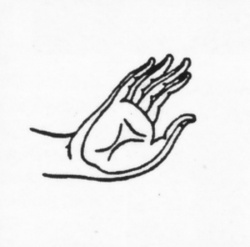Difference between revisions of "Abhaya Mudrā"
Jump to navigation
Jump to search
| Line 1: | Line 1: | ||
[[File:AbhayaMudra.JPG|thumb|250px|]] | [[File:AbhayaMudra.JPG|thumb|250px|]] | ||
<poem> | <poem> | ||
| − | Abhaya Mudrā or Abhayaṃdada Mudrā | + | [[Abhaya Mudrā]] or [[Abhayaṃdada Mudrā]] |
| − | shīwúwèi yìn 施无畏印 施無畏印 | + | [[shīwúwèi yìn]] [[施无畏印 施無畏印]] |
| − | This gesture vanquishes both fear and hostility. It is said that once a vicious demon named Devadatta sent a drunken elephant to trample the Buddha. The Buddha raised his hand gently, and immediately the elephant was subdued. (This is probably a mythologized variant of the story told in chapter 25 of the on-line biography of the Buddha. The mudrā has therefore come to represent protection and peace and the dissipation of all fear in the believer. (Some say it is a pre-Buddhist sign used in greeting another person and signaling one’s good intentions.) This mudrā is often combined with the Wish-Granting Gesture (varada mudrā) | + | This gesture vanquishes both {{Wiki|fear}} and {{Wiki|hostility}}. |
| + | |||
| + | It is said that once a vicious {{Wiki|demon}} named [[Devadatta]] sent a drunken [[elephant]] to trample the [[Buddha]]. | ||
| + | |||
| + | The [[Buddha]] raised his hand gently, and immediately the [[elephant]] was subdued. | ||
| + | |||
| + | (This is probably a mythologized variant of the story told in [[chapter]] 25 of the on-line {{Wiki|biography}} of the [[Buddha]]. | ||
| + | |||
| + | The [[mudrā]] has therefore come to represent [[protection]] and [[peace]] and the dissipation of all {{Wiki|fear}} in the believer. | ||
| + | |||
| + | (Some say it is a pre-Buddhist sign used in greeting another [[person]] and signaling one’s good {{Wiki|intentions}}.) | ||
| + | |||
| + | This [[mudrā]] is often combined with the [[Wish-Granting Gesture]] ([[varada]] [[mudrā]]) | ||
</poem> | </poem> | ||
{{R}} | {{R}} | ||
Latest revision as of 12:25, 31 January 2016
Abhaya Mudrā or Abhayaṃdada Mudrā
shīwúwèi yìn 施无畏印 施無畏印
This gesture vanquishes both fear and hostility.
It is said that once a vicious demon named Devadatta sent a drunken elephant to trample the Buddha.
The Buddha raised his hand gently, and immediately the elephant was subdued.
(This is probably a mythologized variant of the story told in chapter 25 of the on-line biography of the Buddha.
The mudrā has therefore come to represent protection and peace and the dissipation of all fear in the believer.
(Some say it is a pre-Buddhist sign used in greeting another person and signaling one’s good intentions.)
This mudrā is often combined with the Wish-Granting Gesture (varada mudrā)
